Robert Fishman, Professor, University of Michigan
This paper was commissioned by the Regional Plan Association in 2007 for the Rockefeller Urban Summit, and is courtesy of America 2050.
 Robert Fishman Robert Fishman |
Professor Fishman teaches in the urban design, architecture, and urban planning programs at the University of Michigan. He has authored several books regarded as seminal texts, on the history of cities and urbanism including Bourgeois Utopias: The Rise and Fall of Suburbia (1987) and Urban Utopias in the Twentieth Century: Ebenezer Howard, Frank Lloyd Wright, and Le Corbusier (1977). His most recent work is on exurbs.
Professor Fishman is also a featured interview in Blueprint America: Beyond the Motor City.
1808 – 1908 – 2008: NATIONAL PLANNING FOR AMERICA
National planning in this country is widely believed to be an un-American activity, an exercise in bureaucratic hubris best left to the French. In fact, national planning is as American as the family farm, the transcontinental railroads, the great hydro-electric dams of the South and West, and the interstate highway system. Not only were these and other characteristic elements of our culture and economy the product of national planning; the federal government itself was created in large part to overcome the barriers to national planning that existed under the Articles of Confederation. Indeed, I would argue that no other nation has been so profoundly planned as the United States.
In this paper I will discuss the two great “campaigns” of national planning that have profoundly shaped this country: the 1808 “Gallatin Plan” of roads and canals whose themes guided long-term federal policy through the 19th century, and Theodore Roosevelt’s 1908 set of conservation and transportation initiatives that guided the 20th century. My purpose is not merely to correct some myths about American history. As we approach the centennial anniversaries of these two great plans, we might ask: What elements in our tradition of national planning are still valuable and powerful? Where is the new vision for 2008 that can build on the achievements of 1808 and 1908 to reshape the nation over the next century?
The first great national plan bears the name of Thomas Jefferson’s brilliant Secretary of the Treasury, Albert Gallatin, although his 1808 “Gallatin Plan” owed as much to Jefferson himself as to Gallatin. It embodied perhaps the most revolutionary vision of any national plan: the creation of a truly democratic society through the planned settlement of a whole continent. The sale of federal lands would be organized to produce a society dominated by independent farmers, and this new continent of citizen-farmers would be connected to thriving cities and their world-wide markets by a federally-financed network of roads, and canals (and later railroads) to form the world’s most productive economy. This vision dominated the 19th century, reaching its climax during the Civil War years when Lincoln definitively linked the Jeffersonian ideal of the citizen-farmer to the new technology of the railroad. The 1862 Homestead Act promised 160 free acres of federal land to any family that would farm it, while massive federal land grants to the railroads financed a national rail system that opened up millions of acres for settlement.
Indeed, it was the very success of the Jefferson/Gallatin vision through the 19th century that prompted the second campaign of national planning, which began exactly a century after the Gallatin Plan in 1908 with Theodore Roosevelt’s great conservation initiatives. Haste had made waste, a whole continent of it, as the runoff from bare slopes denuded by massive timber cuts had turned fertile valleys into floodplains; eroded soil bankrupted farmers and choked rivers; plowing of semi-arid land threatened dustbowls; and a poverty-stricken rural population streamed into the already-overcrowded cities. Roosevelt’s “New Nationalism” meant a re-assertion of “the common good” as the motive for national planning. This meant a coordinated effort led by the federal government at the scale of the great river valleys. Forests in the highlands would be protected (or replanted if necessary) to restrain flooding; agriculture reformed to minimize soil erosion; the great rivers tamed by dams that would also provide hydro-electric power. In the West, the dams would collect water to irrigate millions of acres and thus spur a new era of homesteading. If the railroads had concentrated industry and population in the cities of the East and Midwest, a new federal system of navigable inland waterways, irrigation and cheap electric power would reinvigorate the economies of the South and West to create a national balance of prosperity and equity.
As with the Gallatin Plan, the 1908 Roosevelt vision exercised its influence over the long term, eventually drawing on new technologies like the regional electric power grid and the automobile superhighway to achieve its ends. The climax of this era’s national planning came in the 1930s, when the New Deal responded to the droughts and dust bowls that accompanied the Depression with a heroic coordinated program of hydroelectric dams, rural highways, electrification and farm subsidies that saved the South and West from catastrophe and made possible their resurgence after 1945. Perhaps the greatest legacy of New Deal national planning is one that is rarely acknowledged: the interstate highway program. Theodore Roosevelt’s dream of an efficient national system of inland waterways to break the monopoly of the railroads was realized on land with the interstate highways that Franklin Roosevelt first envisioned in the late 1930s (and that Dwight Eisenhower finally funded in 1956.)
|
For more on infrastructure projects of the New Deal, listen to Blueprint America: Bridge to Somewhere |
The interstates completed the regional restructuring that was implicit in the 1908 vision, helping to shift population from the rail-dependent cities of the East and Midwest to Sunbelt regions where systems of federally-financed infrastructure (water, electricity, roads, ports, housing) made possible the explosive growth that has re-shaped this country over the last sixty years. Of course, it is part of the mythology of the South and West today that their growth is due to private enterprise and “rugged individualism.” The great paradox of national planning is that Americans have practiced it so successfully while continually claiming it doesn’t exist.
Indeed, one might argue that the remarkable power of planning in this country is proportional to the strength of the barriers it must continually overcome. These include the continent-spanning scale of effective national planning; the centrality of private property and its rights in our economy and culture; and the federal system of government itself with its complex division of powers. National planning in this country has therefore always been innovative and opportunistic, exploiting the flexibility in the federal system to bypass opposition while constantly seeking new coalitions of stakeholders that can advance the goals.
When, for example, federal initiatives on the Gallatin Plan in the 1820s-1850s were stymied by the conflict between North and South, the initiative passed to the states that actually built the canals that Gallatin had envisioned. In the 20th century, Theodore Roosevelt announced his 1908 conservation initiatives at a White House conference that brought together all the nation’s governors with members of Congress, the Supreme Court, and even included such “stakeholders” as the industrialist Andrew Carnegie and the populist William Jennings Bryan. Moreover, to carry out the initiatives, the federal government drew on the expertise and support of the great cities, where organizations like the Chicago Plan Commission and the Regional Plan Association of New York had already amassed the planning skills that national planning required.
Alexis de Tocqueville was perhaps the first to recognize the special character of American planning in his classic Democracy in America. When Tocqueville visited the United States in the 1830s, he observed that the country lacked the top-down government bureaucracies that carried out planning in France, and yet, in the United States, much more was actually accomplished because the relatively open American system encouraged citizen activism and cooperation. “Democracy,” he wrote, “does not give the people the most skillful government, but it produces what the most able governments are frequently unable to create: a superabundant force, and an energy which is inseparable from it, and which may, however unfavorable circumstances may be, produce wonders.” [1]
1808: THE GALLATIN PLAN
 Albert Gallatin Albert Gallatin |
When in 1908 the Inland Waterways Commission published its landmark Preliminary Report, the volume that would set so many of the goals for American national planning for the rest of the 20th century, its authors included as an appendix the 1808 Gallatin Report. [2] This was not mere antiquarianism. Albert Gallatin’s Report on Roads and Canals had not only achieved over the course of the 19th century the deep influence on the country that the 1908 conservationists hoped to achieve in the 20th; but Gallatin’s Report remained in 1908 (and, I would argue, still in 2008) a model of long-term strategic thinking tied to national policy. The plan clearly identified a set of key infrastructure investments for the federal government, and related those investments to what were perhaps the two most important “policy goals” in the history of the early Republic. The first was Thomas Jefferson’s determination that the vast lands controlled by the national government beyond the borders of the original thirteen states be sold under conditions carefully designed to create a nation of independent small farmers. The second was George Washington’s determination that the newly-settled lands in the American interior be linked to the markets and Atlantic ports of the East Coast to ensure that the United States remained prosperous and united.
Indeed, one might say that not only the Gallatin Plan but the federal Constitution itself derived directly from Washington’s conviction that the new nation must have the capacity to engage in national planning. One of his greatest concerns after the victory over the British in 1783 was that the new nation might break apart because of the physical barriers to effective trade and communication, most notably the great barrier of the Allegheny Mountains that, in an era of water transportation, cut off the western territories from the port cities on the Atlantic. As he wrote to Jefferson in 1784, the settlers already streaming into the fertile Ohio Valley could market their products only by a water route from the Ohio River to the Mississippi and ultimately to New Orleans, then in Spanish hands. Similarly, the settlers along the Great Lakes would have to find their “natural” outlet through the St. Lawrence and British Canada. [3]
Washington’s solution to this problem was a coordinated system of canals and portage roads across the Alleghenies, especially one that would connect the Ohio River to a navigable Potomac River; Jefferson replied to Washington’s concept with the enthusiastic concurrence that “Nature then has declared in favor of the Potomac, and through that channel offers to pour into our laps the whole commerce of the Western world.”4 But nature required human assistance, especially canal locks around the Potomac’s five major waterfalls, and Washington soon discovered that even his preliminary efforts to extend navigation required a formal treaty between Maryland and Virginia and elaborate approvals from other states and from the Continental Congress. To settle this dispute Washington convened a meeting between Maryland and Virginia legislators at Mount Vernon in 1785; their dissatisfaction with the barriers that the Articles placed to interstate commerce and “improvements” led them to convene the Annapolis Convention in 1786 to which leaders from the 13 states were invited; the Annapolis Convention then issued the call for a Constitutional Convention to meet in Philadelphia in 1787. The Constitution is thus in a real sense a charter for national planning; the Commerce Clause gives Congress the power to regulate interstate commerce to create, in the words of the preamble, a “more perfect union.” James Madison in his Federalist Paper #14 specifically defended the new Constitution as forming a government that would unite the country through new roads and canals. Nevertheless, the debts and conflicts accompanying the new federal government postponed such national planning until Thomas Jefferson’s administration. Although Jefferson, as we have seen, agreed with Washington’s goals, he had his own strong motives for a national system of roads and canals.
From the early 1780s, when the Continental Congress had won control of all the land in the western territories not in the original 13 states, Jefferson had seen this vast unsettled landscape as the potential site of a truly democratic society. He too put forward a plan perhaps even more ambitious than Washington’s: to sell the land in small units for family farms that would be the economic underpinning of a political democracy. He realized that the difficulty for such sales was a subtle one: the inability in an unsettled wilderness to provide clear title and boundaries to small plots. His solution had all the simplicity and rigor of the Enlightenment: a vast land survey to map the whole Western territories on a square-mile “continental grid” oriented to the cardinal points of the compass. Once the base-points had been scientifically established, every inch of land could then be accurately mapped and subdivided. Land to be sold would be grouped into “townships” six miles by six miles (the local political unit for the new territories), and the 36 square-mile “sections” that made up a township would be sold either as complete sections (640 acres), half (320) or quarter-sections (160 acres, thought to be the smallest unit that could support a family). Thus, with a simple set of measurements that even a neophyte surveyor could carry out, Jefferson proposed a “national plan” for a democratic society.
But this plan was incomplete, for exactly the reasons that Washington had foreseen: the lack of a transportation infrastructure to get crops to market. The Gallatin Plan in effect put Washington and Jefferson together: a national system of roads and canals would open up vast land tracts for sale by the federal government; the revenue from these sales would pay for the new infrastructure; and the Plan would ultimately create a new egalitarian society. The Plan therefore had two main components: (1) a set of roads and canals to improve transportation along the Atlantic coastline, including a north-south national turnpike road (the earliest version of Interstate 95) and canals cutting across Cape Cod, New Jersey from the Raritan to the Delaware, the Delmarva peninsula, and the Dismal Swamp to shorten intercoastal shipping routes; and (2) the more difficult, expensive but vitally necessary canal and road systems over the Alleghenies. Here Gallatin proposed four: an all-water route in New York State via the Hudson and Mohawk Rivers to a new canal to connect with Lake Ontario; and three water-and-road routes where the eastern river would be made navigable as far west as possible, and a road to carry goods the remaining distance over the mountains to a western river. These “hybrids” included Washington’s beloved Potomac with a road over the mountains to the Monongahela and Ohio; the Susquehanna and Juniata with a road connecting to the Allegheny; the James River with a mountain road to the Kanawha; and the Savannah River with a mountain road to the Tennessee. [5]
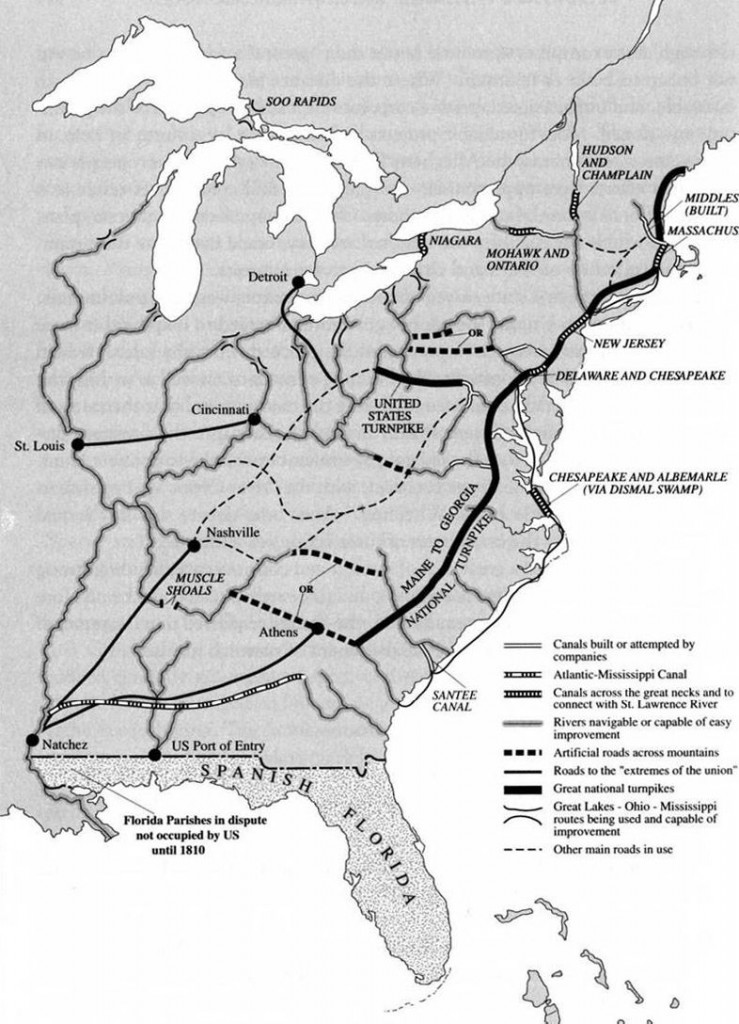 The Gallatin Plan, 1808, as reconstructed in D.W. Meinig, The Shaping of America, vol. II (1993). |
Having advanced a truly national vision, Gallatin was remarkably flexible about the exact federal role in these projects. All would be “private-public partnerships” with the federal government advancing loans or purchasing stock in the canal companies. His hope was that in each case federal funds would overcome the limitations of the private capital market to permit the rapid and coordinated completion of all these projects. That hope was not fulfilled. The War of 1812 drained away (as wars tend to do) the federal surplus that Gallatin hoped would be available for infrastructure. More seriously, the great divide between slave and free states made a truly National System (as Henry Clay and John Quincy Adams styled their later versions of the Gallatin Plan) impossible.
Here the supposed weakness of the federal system – its division of powers between the national government and the states – became an unexpected strength for national planning. With the federal government deadlocked, the states took the initiative, led by New York. Governor DeWitt Clinton saw the possibility of a canal far more ambitious than Gallatin’s: a 363-mile link through the Mohawk Valley between the Hudson River at Albany and Lake Erie at Buffalo. With strong support from New York merchants, this remarkable technological achievement was completed in 1825. In the absence of the other canal-road systems that Gallatin had advocated, the Erie Canal profoundly changed the political economy of the nation. As Washington had recognized in the 1780s, the “natural” route of commerce in the vast Mississippi Valley ran through St. Louis and New Orleans. Although New Orleans was now part of the United States, the nation’s river system still seemed to dictate that the nation’s greatest port city – the port that gave access to the vast commerce that would flow down the Mississippi – would be the great port of the slave system.
The Erie Canal in effect turned the nation’s commerce a full 90 degrees. The greatest natural port on the Atlantic – New York – now had direct water access through the Great Lakes into the heart of the very territory that Jefferson had designated for free settlement. Moreover, the Erie Canal gave a new meaning to a swampy village on the shores of Lake Michigan that happened to occupy the narrow ridge between the lake and the headwaters of the Illinois, a river that drained into the Mississippi. The village was called Chicago. With the Erie Canal, Chicago became the key central point on the continent, drawing goods from throughout the Mississippi River basin and transferring them to the Great Lakes system, the Erie Canal and the international trade of the port of New York. Thus the “commerce of the Western world” poured not into New Orleans, as Washington and Jefferson had feared, or into the Potomac ports like Alexandria as they had hoped, but into the capacious lap of New York. With other states joining the “canal boom” touched off by the Erie Canal, Gallatin’s and Jefferson’s national plan was realized in different form and by different actors. But the federal government regained its direct power over national planning in the 1860s, when the secession of the Southern states in the Civil War broke the deadlock that had paralyzed the national government. With the strong support of Abraham Lincoln, Congress in 1862 passed the Homestead Act that awarded 160 free acres of federal land to any family that would claim and farm it. In the same year Congress passed the Pacific Railway Act, authorizing the first transcontinental railroad (completed in 1869).
Lincoln in effect brought to fruition the work of national planning that Washington, Jefferson, and Gallatin had begun. The Homestead Act was Jefferson’s 1784 Land Ordinance on steroids. Further, Lincoln tied this new tide of settlement to federal support for the most powerful technology of the 19th century: the railroad. The massive federal land grants that financed the completion of the national rail grid in the second half of the 19th century accomplished what Gallatin’s proposed federal loans and stock purchases never could: the rapid and coordinated completion of a national transportation system that completed the Gallatin vision at a scale and in a form that Gallatin himself could never have imagined.
Nevertheless, the very power of this alliance of the homesteaders, the railroads, and the federal government had unintended consequences that vitiated much of the democratic idealism that underlay the 1808 plan. The millions of acres of railroad land grants meant that most settlers in fact bought their land from the railroads, a process that concentrated wealth in the hands of an urban elite and left many farmers in a state of dependency that Jefferson would have abhorred. Moreover, the railroads became the leading players in an economy of extreme speculation, exploitation and waste that consumed whole forests, tore up fragile prairies for unsustainable farming, and polluted whole river systems. This was not what Gallatin had planned. After 100 years, his vision had run its course, to be replaced by a new national planning initiative.
1908: NATIONAL CONSERVATION AND DEVELOPMENT
The most decisive two days for American domestic policy in the 20th century were arguably May 13-15, 1908 when President Theodore Roosevelt convened a “Conference of the Governors of the United States” at the White House. A year earlier, Roosevelt had proclaimed, “the conservation of our natural resources and their proper use constitute the fundamental problem that underlies almost every other problem of our National Life.” [6] In his call to the Conference, he drew the conclusion that “unless we solve [the conservation] problem, it will avail us little to solve all others. To solve it, the whole nation must undertake the task through their organizations and associations, through the men whom they have made specifically responsible for the welfare of the several States, and finally through Congress and the Executive.” [7] To carry out what Roosevelt understood was a new national plan, he had resolved to bring together at the White House Conference not only the governors of the forty-six states and four territories, but also leading members of Congress, the Supreme Court, the Cabinet, government bureaus, learned and professional organizations, and the press. Only by the cooperation of all these “stakeholders” could Roosevelt forge the new relationship between the federal government, the states, and the public that the plan required. [8]
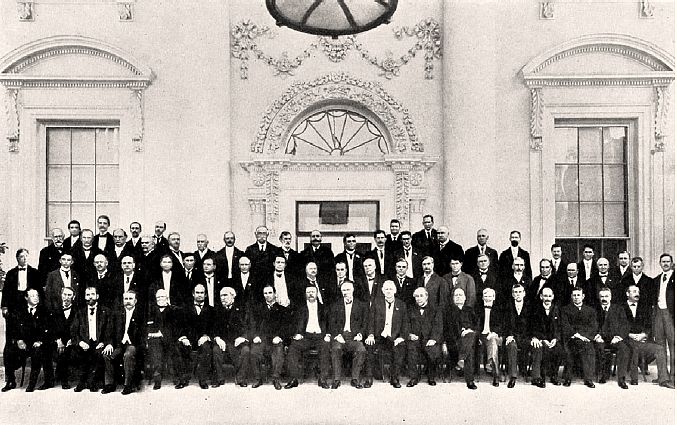 President Theodore Roosevelt (first row, center), governors and other notables in attendance at the White House Governors Conference, May 15, 1908. Notables in the first row include Andrew Carnegie (fifth from left) sitting next to William Jennings Bryan (sixth from left). Justice Oliver Wendell Holmes, Jr. is seated fifth from right. From the conference proceedings (1908). President Theodore Roosevelt (first row, center), governors and other notables in attendance at the White House Governors Conference, May 15, 1908. Notables in the first row include Andrew Carnegie (fifth from left) sitting next to William Jennings Bryan (sixth from left). Justice Oliver Wendell Holmes, Jr. is seated fifth from right. From the conference proceedings (1908). |
The agenda for this unprecedented meeting was set by a now-forgotten document whose unpromising title was the Preliminary Report of the Inland Waterways Commission. And yet this 1908 publication, more than any other, initiated the new era in national planning that would supersede the exhausted principles of the Gallatin Plan and offer a vision for the 20th century. This Report not only translated the progressive ideals of the conservation movement that had been building over the last decade into a coherent framework for national action that would put the “common good” over private profit. But the report also encapsulates a highly strategic understanding among the scientists who were its authors and the politicians who were its sponsors that the inland waterways were the strategic site for a comprehensive effort in national planning that had the power to conserve natural resources and bring prosperity to the neglected regions of the United States.
First, the rivers, as George Washington intended in 1787, are undeniably in the public domain – public resources for navigation and clean water, but also public menaces in conditions of flood and pollution. And, as government and hydrologists and foresters like Gifford Pinchot well understood, to “regulate” a river basin to prevent disastrous flooding meant conservation measures reaching far into its watershed: to the uplands where healthy forests alone could retain water; to the agricultural plains where scientific farming could prevent disastrous soil erosion that bankrupted farmers and choked rivers; to the industrial cities where proper sewage treatment could prevent pollution. Controlling a river also gave important positive benefits; a great dam not only held back flood waters and ensured safe navigation, but it also generated cheap electrical power for the surrounding region and stored fresh water for the irrigation of millions of arid acres. Finally, the clean, controlled, well-dredged riverways could serve as transportation corridors, efficient alternatives to the railroads with their “monopoly” rates. [9]
We have since learned the many environmental costs of dams and irrigation projects, but to Theodore Roosevelt and the other Progressives a great dam signified a triumph of the wise and daring use of advanced technology in the public interest. For them, the dams were the central monuments in a program of what we would today call “sustainable economic development” at a regional scale. A pervasive theme that would extend from TR’s “New Nationalism” to FDR’s New Deal was that the 19th century alliance of the federal government and the railroads had fostered “monopolies” that had concentrated development in the great industrial cities of the Northeast and Midwest and, through discriminatory freight rates and other disincentives, had reduced the South and West to mere “colonies” providing cheap raw materials. This economic exploitation had in turn encouraged the inefficient exploitation of natural resources, as poor farmers were forced onto marginal lands, lumbermen overcut forests, and miners pillaged mineral resources to supply the great cities. Conservation for both Roosevelts and other Progressives thus meant fundamental economic reform to break the monopoly power of the railroads and the “trusts” and spread economic equity throughout the country.
The distribution of potential sites for dams and electric power generation through many of the poorest areas of the South and West seemed an almost providential circumstance for the national economic restructuring that was at the heart of the conservation ideal. The Preliminary Report of the Inland Waterways Commission had already put forward a detailed blueprint for focusing the national conservation effort at the scale of the river basin. The Governors Conference was intended to re-shape the federal government to operate effectively and in cooperation with the states at that scale. The Conference Declaration called for the creation of a permanent National Conservation Commission which would work closely with parallel state commissions as the national planning body for the conservation movement:
We agree that the land should be so used that erosion and soil-wash shall cease…that the waters should be so conserved and used to promote navigation, to enable the arid lands to be reclaimed by irrigation, and to develop power in the interests of the People; that the forests…should be preserved and perpetuated; that the minerals…be so used to prolong their utility; that the beauty, healthfulness, and habitability of our country should be preserved and increased; and that the sources of national wealth exist for the benefit of the People, and that monopoly thereof should not be tolerated. [10]
Despite the idealism, science, and political power that lay behind this Declaration, the new era of national planning it announced would be marginalized for the next twenty-five years. The successful implementation of the public dam-water-and-power concept at the appropriately-named Roosevelt Dam over the Salt River near Phoenix was completed in 1911, but Roosevelt’s successors mistrusted the use of federal planning power he had championed, and the private electric utilities in particular proved to be bitter enemies. As with the Gallatin Plan, the Roosevelt “National Conservation” plan fell victim to a deep split in American society, in this case over the proper boundaries between private and public enterprise. Only the Colorado River Compact of 1922 and the Boulder (now Hoover) Dam begun in 1931 escaped this deadlock. And, as in the Gallatin Plan, the full potential of the plan was only realized decades later after a national trauma had broken the federal deadlock: for the Gallatin Plan, the Civil War, for national conservation and development, the Great Depression and the coming of the New Deal.
Franklin Delano Roosevelt in the 20th century thus played Abraham Lincoln’s 19th role as the leader who finally implemented the national plan with the federal resources and authority it deserved. The combined environmental/economic crisis that reached its climax in the Dustbowl that consumed the western prairie states swept away opposition. The Tennessee Valley Authority took up the exact vision of the Inland Waterways Commission and made coordinated conservation/development planning the keynote of New Deal policy. And TVA was the template for a national effort of forest and farmland preservation and rivershed planning that saved the most devastated regions of the country from disaster. [11]
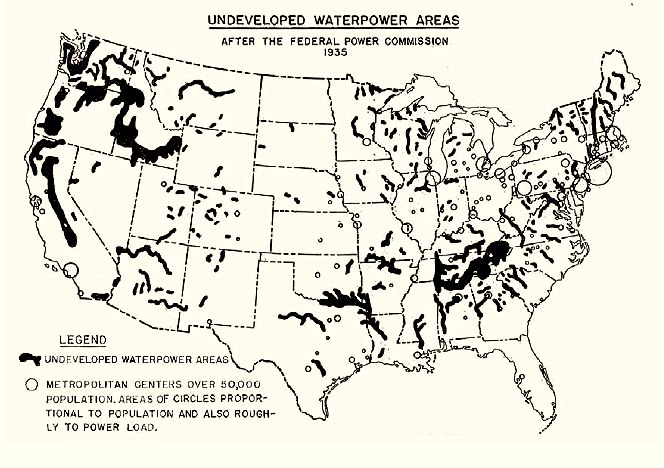 This dramatic map of “undeveloped water power areas” suitable for hydro-electric dams shows clearly the federal dam program as a development tool for “undeveloped” regions of the South and West. This dramatic map of “undeveloped water power areas” suitable for hydro-electric dams shows clearly the federal dam program as a development tool for “undeveloped” regions of the South and West. |
With the enthusiastic support of Secretary of the Interior Harold Ickes, a veteran Chicago conservationist and progressive, Roosevelt even revived the 1908 idea of a national planning office in the form of the “National Planning Board,” better known under its 1939 title as the “National Resources Planning Board.”12 To lead this national planning effort, Roosevelt chose his uncle, Frederic Delano. This was no nepotism, for Delano had been deeply involved in urban and regional planning since his days as a railroad executive in Chicago. He had been a main sponsor of Daniel Burnham’s monumental 1909 Plan of Chicago. After moving to New York City in 1912, he brought with him the Chicago regional planning ideal, and helped to initiate the 1920s Regional Plan of New York and Its Environs, serving as the first chairman of New York’s Regional Plan Association. Delano’s colleagues on the National Resources Planning Board had also been deeply involved in city and regional planning: political
scientist Charles Merriam had been the leading advocate for regional planning in Chicago and planner Charles Eliot II had played a similar role in Boston and Washington, D.C.
These city and regional connections were no coincidence. Just as in the early 19th century when the states took up the task of canal building when the federal government was deadlocked, so in the early 20th century, the nation’s urban leadership took up the task of planning for the new society, but at the city and regional level. The Chicago and New York plans were the best existing models for long-term intensive planning for conservation and development. These plans projected and coordinated massive infrastructure development for clean water, clean air, road and rail improvements, even the conservation of “forest preserves” and open space at their edge. Now this expertise would be used for national conservation and development.
This carry-over from the region to the nation was perhaps most clearly seen in the New Deal’s national highway planning that initiated the interstate highway system. Although the federal government through its Bureau of Public Roads in the Agriculture Department had been subsidizing rural “farm-to-market” roads and other projects since 1916, road-building through the 1930s had been primarily a city, county, and state responsibility. But, as we have seen, the 1908 Inland Waterways Commission had already identified an unbalanced transportation system dominated by railroad monopolies as a major source of economic inefficiency and regional imbalance. By the 1930s a new possibility for an alternative national transportation system had eclipsed the inland waterways: the express or “superhighway.” In 1937 Pennsylvania had taken the lead with its plan for a toll-financed Pennsylvania Turnpike, designed to be the 20th century equivalent of the Erie Canal and thus to funnel the east-west automobile traffic of the nation through Pennsylvania. The Pennsylvania Turnpike inspired a vision of a national network of “superhighways;” at Frederic Delano’s urging, FDR in 1938 charged the National Resources Planning Board and the Bureau of Public Roads with planning such a system. [13]
The resulting national highway plan, first published in 1939 under the title Toll Roads and Free Roads, was the equivalent of the transcontinental railway plans and land grants of the Lincoln years.14 The seemingly irrelevant title in fact was the key to the plan. After extensive research, the Bureau of Public Roads concluded that toll roads like the Pennsylvania Turnpike would be viable only in the heavily-traveled routes of the Northeast and Midwest. A system of toll superhighways would thus reinforce the dominance of those regions and perpetuate the pattern established by the railroads. This went counter to the national purpose that had been established since 1908 of using a new system of transportation to spread growth through the nation. So the Bureau of Public Roads and the National Resources Planning Board strongly advocated a true national system of “free” interstate highways as a key tool for balanced national growth. The map of a 33,000 mile national system published in Toll Roads and Free Roads thus became the key document for 20th century American national transportation planning, although implementation was delayed by World War II and the inevitable conflicts over funding until the 1956 Interstate Highway Act funded the 41,000-mile system proclaimed at the time as “the largest construction project since the Pyramids.”
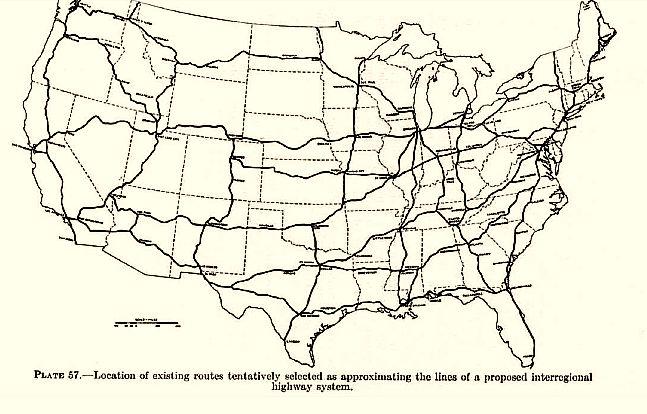 The first map of a national interstate highway system. From Toll Roads and Free Roads (1939). The first map of a national interstate highway system. From Toll Roads and Free Roads (1939). |
Just as Lincoln in the 1860s had allied the federal government with the most advanced technology of the time – the steam locomotive – to promote the settlement of the nation, so FDR had allied the federal government with the hydroelectric dam, the regional electric grid, the internal combustion engine, and the superhighway to develop the South and West. Bringing the most advanced 20th century systems of power and transportation to the relatively “backward” regions of the country was indeed wonderfully effective in re-structuring the geography of population and economic growth. Indeed, I would argue that this massive exercise in national planning gave American capitalism its “second wind” after the Depression and World War II, and has been the most important initiative in creating the country we know today.
CONCLUSION
As I have tried to show in this paper, national planning in the United States is difficult but it works. Twice in our history our leaders have managed to overcome the inevitable constraints – regional and sectional divisions, private-public conflicts, divisions of power, the sheer magnitude of the task of transforming a continent – and crafted national plans whose visions have had the galvanizing power to coordinate action over the long term. I have used the dates 1808 and 1908 as shorthand for these two great national efforts.
In October 1907 President Theodore Roosevelt led an extraordinary study-tour of the Mississippi aboard the USS Mississippi. Accompanied by his Chief Forester and conservation visionary Gifford Pinchot and the members and staff of the Inland Waterways Commission, Roosevelt saw first-hand the results of wanton destruction of forests and the inevitable soil erosion, flooding, and rural poverty that followed. Where Mark Twain in the 1850s had recorded a bustling commerce carried in hundreds of paddle-wheelers, the group saw virtually no river transport at all, due in large part to railroad policies that suppressed alternative and more efficient means of transportation. Discussions aboard the Mississippi inspired Roosevelt to disembark at Memphis to issue the call for the 1908 Governors Conference that would begin a new era in national planning. The conference, Roosevelt observed, “ought to be among the most important gatherings in our history, for none have had a more vital question to consider.” [15]
A century later, we await a new vision and a new call.
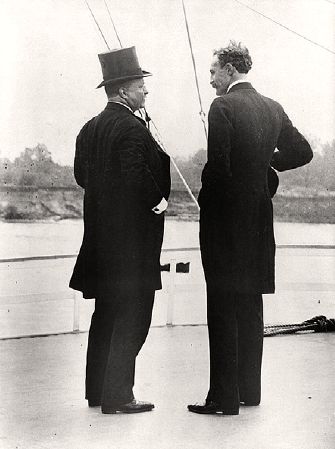 President Theodore Roosevelt and then Chief of the Forestry Service Gifford Pinchot aboard the U.S.S. Mississippi on the historic 1907 cruise down the lower Mississippi undertaken by the Inland Waterways Commission that led to the 1908 Governors Conference. || Source: Library of Congress Conservation Collection President Theodore Roosevelt and then Chief of the Forestry Service Gifford Pinchot aboard the U.S.S. Mississippi on the historic 1907 cruise down the lower Mississippi undertaken by the Inland Waterways Commission that led to the 1908 Governors Conference. || Source: Library of Congress Conservation Collection |
ENDNOTES
[1] Alexis de Tocqueville, Democracy in America, ed. Richard D. Hefner (New York: New American Library, 1956; original published in 1835 and 1840), p. 108.
[2] Albert Gallatin, Report to the Senate on Roads and Canals [April 1808], reprinted as Appendix 17 in Preliminary Report of the Inland Waterways Commission (Washington, D.C.: Government Printing Office, 1908), pp. 535-581.
[3] Washington to Jefferson, March 15, 1784, Jefferson Paper, “American Memory” website, Library of Congress.
[4] Jefferson to Washington, March 29, 1984. op. cit.
[5] Gallatin Report, pp. 535-560. See especially Michael J. Lacey, “Federalism and National Planning: The Nineteenth Century Legacy,” in Robert Fishman, editor, The American Planning Tradition: Culture and Policy (Baltimore: Johns Hopkins, 2000). Pp. 89-146. Anyone who knows this remarkable essay with more than a book’s worth of thought and research, will recognize my debt to Lacey, who served as Director of United States Studies at the Wilson Center.
[6] Theodore Roosevelt, Address to the National Editorial Association, June 10, 1907. Roosevelt Papers, American Memory Website, Library of Congress.
[7] Theodore Roosevelt, “Call to Governors Conference, Memphis, October 3, 1907. Loc. Cit.
[8] Proceedings of a Conference of Governors in the White House, Washington, D.C. May 13-15, 1908 (Washington, D.C.: Government Printing Office, 1909). Henceforth cited “Governors Conference.”
[9] Preliminary Report of the Inland Waterways Commission, pp. 1-32.
[10] Governors Conference, p. 193.
[11] Philip Selznick, TVA and the Grass Roots (New York: Harper Torchbacks, rev. ed. 1966).
[12] Alan Brinkley, “The National Resources Planning Board and the Reconstruction of Planning,” chapter in Fishman, editor, The American Planning Tradition, pp. 173-192.
[13] John H. Crider, “$8,000,000,000 Highway Project Wins Encouragement of Roosevelt, New York Times, Feb. 7, 1938, p. 1.
[14] Toll Roads and Free Roads (Washington, D.C.: Government Printing Office, 1939).
[15] Theodore Roosevelt, “Call to the Governors Conference,” loc. cit.
———————————————————————–
 AMERICA 2050 is a national initiative to meet the infrastructure, economic development and environmental challenges of the nation as it prepares to add about 130 million additional Americans by the year 2050.
AMERICA 2050 is a national initiative to meet the infrastructure, economic development and environmental challenges of the nation as it prepares to add about 130 million additional Americans by the year 2050.
For more on America 2050, visit www.america2050.org.


